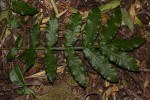Bersama abyssinica
engleriana
Selected images: Click on each image to see a larger version and details of the record View all images (1)
Detailed records: Display species records QDS maps by: Google Maps Point records by Google Maps
Species details: Click on each item to see an explanation of that item (Note: opens a new window)
| Synonyms: |
Bersama englerana Gürke |
| Common names: | |
| Frequency: | |
| Status: | Native |
| Description: |
See Bersama abyssinica for general description details. This subspecies differs in the rhachis being winged, undersides of the leaves mostly hairless or with a few hairs on the midrib and lateral veins and the leaflets with the margins entire or deeply toothed. The flowers are generally larger with petals up to 18 mm long and the calyx with golden hairs or pink-tinged. |
| Type location: |
|
| Notes: | |
| Derivation of specific name: | abyssinica: of Abyssinia (Ethiopia); engleriana: after Dr Prof Heinrich Gustav Adolf Engler (1844-1930), German Director of the Royal Botanical Gardens in Berlin, who promoted botanical exploration in Africa |
| Habitat: | In evergreen thicket and forest, sometimes in fire-protected Brachystegia woodland. |
| Altitude range: (metres) | |
| Flowering time: | |
| Worldwide distribution: | Angola, Nigeria, Uganda, Sudan, Ethiopia, Kenya, Tanzania, Malawi, Mozambique, Zambia and Zimbabwe. |
| FZ divisions: | N,C,S |
| Growth form(s): | |
| Endemic status: | |
| Red data list status: | |
| Insects associated with this species: | |
| Spot characters: | Display spot characters for this species |
| Images last updated: | Wednesday 7 November 2018 |
| Literature: |
Burrows, J.E. & Willis, C.K. (eds) (2005). Plants of the Nyika Plateau Southern African Botanical Diversity Network Report No. 31 SABONET, Pretoria Page 210. Burrows, J.E., Burrows, S.M., Lötter, M.C. & Schmidt, E. (2018). Trees and Shrubs Mozambique Publishing Print Matters (Pty), Cape Town. Page 542. (Includes a picture). Dowsett-Lemaire, F. (1989). The flora and phytogeography of the evergreen forests of Malawi. I: Afromontane and mid-altitude forests; Bull. Jard. Bot. Nat. Belg. 59(1/2) Page 20. Drummond, R.B. (1975). A list of trees, shrubs and woody climbers indigenous or naturalised in Rhodesia. Kirkia 10(1) Page 257. As Bersama abyssinica englerana Mapaura, A. & Timberlake, J. (eds) (2004). A checklist of Zimbabwean vascular plants Southern African Botanical Diversity Network Report No. 33 Sabonet, Pretoria and Harare Page 62. Strugnell, A.M. (2006). A Checklist of the Spermatophytes of Mount Mulanje, Malawi Scripta Botanica Belgica 34 National Botanic Garden of Belgium Page 122. White, F. (1966). Melianthaceae Flora Zambesiaca 2(2) Pages 545 - 546. As Bersama abyssinica englerana |
Other sources of information about Bersama abyssinica subsp. engleriana:
Our websites:
Flora of Mozambique: Bersama abyssinica subsp. englerianaFlora of Zambia: Bersama abyssinica subsp. engleriana
Flora of Zimbabwe: Bersama abyssinica subsp. engleriana
External websites:
African Plants: A Photo Guide (Senckenberg): Bersama abyssinicaAfrican Plant Database: Bersama abyssinica
BHL (Biodiversity Heritage Library): Bersama abyssinica
EOL (Encyclopedia of Life): Bersama abyssinica
GBIF (Global Biodiversity Information Facility): Bersama abyssinica
Google: Web - Images - Scholar
iNaturalist: Bersama abyssinica
IPNI (International Plant Names Index): Bersama abyssinica
JSTOR Plant Science: Bersama abyssinica
Mansfeld World Database of Agricultural and Horticultural Crops: Bersama abyssinica
Plants of the World Online: Bersama abyssinica
Tropicos: Bersama abyssinica
Wikipedia: Bersama abyssinica
